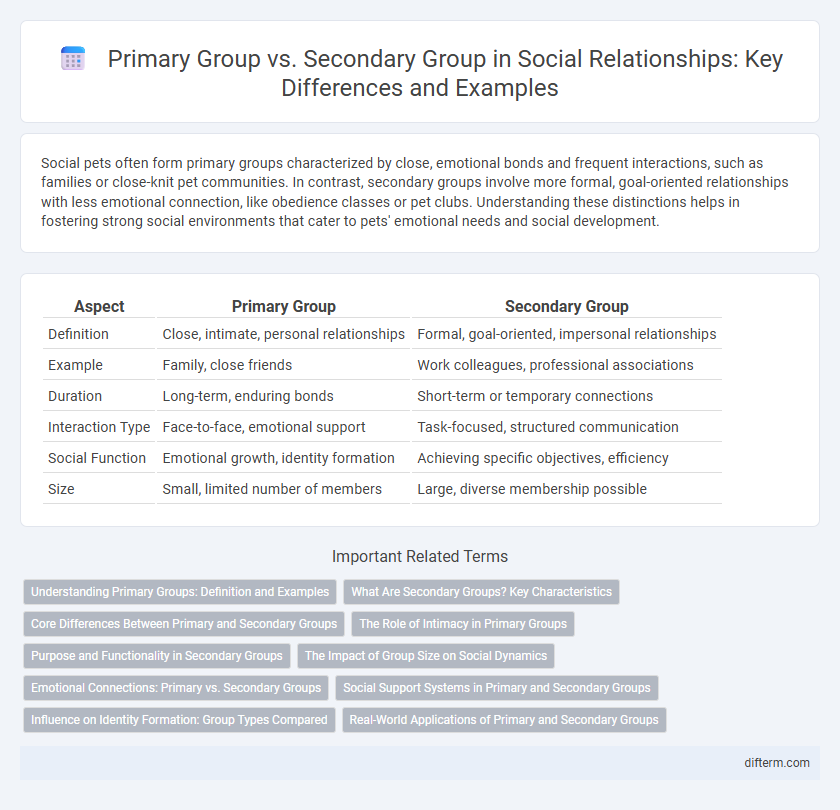Social pets often form primary groups characterized by close, emotional bonds and frequent interactions, such as families or close-knit pet communities. In contrast, secondary groups involve more formal, goal-oriented relationships with less emotional connection, like obedience classes or pet clubs. Understanding these distinctions helps in fostering strong social environments that cater to pets' emotional needs and social development.
Table of Comparison
| Aspect | Primary Group | Secondary Group |
|---|---|---|
| Definition | Close, intimate, personal relationships | Formal, goal-oriented, impersonal relationships |
| Example | Family, close friends | Work colleagues, professional associations |
| Duration | Long-term, enduring bonds | Short-term or temporary connections |
| Interaction Type | Face-to-face, emotional support | Task-focused, structured communication |
| Social Function | Emotional growth, identity formation | Achieving specific objectives, efficiency |
| Size | Small, limited number of members | Large, diverse membership possible |
Understanding Primary Groups: Definition and Examples
Primary groups are small, close-knit social circles characterized by intimate, face-to-face interactions and strong emotional bonds, such as family members and close friends. These groups play a crucial role in shaping an individual's identity, values, and social behaviors through continuous and direct communication. Examples include nuclear families, childhood friends, and support groups where personal and enduring relationships are maintained.
What Are Secondary Groups? Key Characteristics
Secondary groups are larger, more impersonal social collectives formed around specific goals or activities, such as workplaces, professional associations, or clubs. Key characteristics include limited emotional connections, formalized roles, and goal-oriented interactions that differ from the intimate, enduring bonds typical of primary groups. These groups facilitate cooperation among individuals who may not interact on a personal level but share common interests or objectives.
Core Differences Between Primary and Secondary Groups
Primary groups are characterized by intimate, face-to-face interactions, emotional depth, and long-term relationships, such as family and close friends. Secondary groups involve formal, impersonal connections oriented toward specific goals or tasks, like coworkers or professional associations. The core differences lie in emotional closeness, duration of relationships, and the purpose of interaction within each group type.
The Role of Intimacy in Primary Groups
Intimacy in primary groups fosters deep emotional connections, trust, and mutual support, which are essential for individuals' social and psychological well-being. These groups, such as family and close friends, provide a secure environment for sharing personal experiences and developing a strong sense of identity. Unlike secondary groups, where interactions tend to be goal-oriented and impersonal, the intimacy in primary groups creates enduring bonds that shape social behavior and emotional growth.
Purpose and Functionality in Secondary Groups
Secondary groups primarily serve instrumental purposes, focusing on achieving specific goals and tasks rather than fostering emotional bonds. These groups are often larger, more formal, and characterized by impersonal relationships, emphasizing efficiency and productivity. Examples include workplaces, professional associations, and committees where collaboration centers on shared objectives and structured roles.
The Impact of Group Size on Social Dynamics
Primary groups, characterized by small, close-knit memberships such as family and close friends, foster intense emotional bonds and direct interactions crucial for individual identity formation and social support. Secondary groups, often larger and more impersonal like workplaces or associations, emphasize task-oriented relationships and formal roles that facilitate efficiency and broader social networking. The size of the group significantly impacts social dynamics by influencing the depth of interpersonal connections, communication patterns, and the overall cohesion and function within the group.
Emotional Connections: Primary vs. Secondary Groups
Primary groups are characterized by strong emotional connections, close-knit relationships, and a sense of belonging, often found within family and close friends. Secondary groups exhibit weaker emotional bonds, typically centered around specific goals or tasks, such as coworkers or classmates. Emotional depth in primary groups fosters trust and support, whereas secondary groups focus more on formal interactions and limited personal involvement.
Social Support Systems in Primary and Secondary Groups
Primary groups, characterized by close, enduring relationships such as family and close friends, provide vital emotional support, trust, and a sense of belonging essential for psychological well-being. Secondary groups, including coworkers, professional associations, and community organizations, offer instrumental support like information, resources, and goal-oriented assistance necessary for achieving specific objectives. Social support systems in primary groups emphasize emotional bonding, while secondary groups focus on practical aid and social networking opportunities.
Influence on Identity Formation: Group Types Compared
Primary groups, such as family and close friends, provide emotional support and play a crucial role in shaping an individual's self-concept and core identity. Secondary groups, including coworkers and professional associations, influence social roles and behaviors rather than deep-seated personal identity. The intensity of interaction and emotional bonds in primary groups leads to stronger, long-lasting impacts on identity formation compared to the more goal-oriented and temporary nature of secondary groups.
Real-World Applications of Primary and Secondary Groups
Primary groups, such as family and close friends, provide emotional support, social identity, and a sense of belonging essential for individual well-being. Secondary groups, including coworkers and professional associations, facilitate goal-oriented interactions and collaboration in organizational settings. Understanding these distinctions helps improve teamwork, workplace communication, and community-building strategies in social and professional environments.
primary group vs secondary group Infographic

 difterm.com
difterm.com